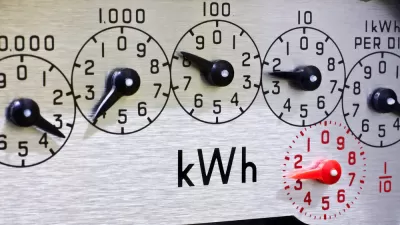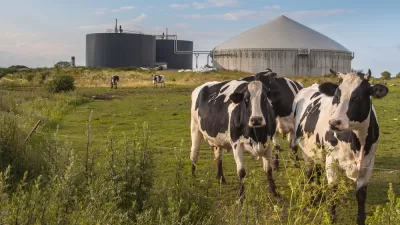Within ten years, passengers flying on JetBlue out of JFK will leaving a much lower carbon footprint, thanks to a fuel composed of 30 percent biofuel.

Despite being more expensive than 'fossil' or 'petro' jet fuel, JetBlue signed a 10-year purchase agreement with Philadelphia-based bioenergy company, SG Preston, in what is considered to be 'one of the largest renewable jet fuel purchase agreements In aviation history, reports Diane Cardwell, a Business Day reporter for The New York Times.
“It’s thinking long term about our biggest cost, but its primary motivation is to reduce our greenhouse gases,” said Sophia Mendelsohn, JetBlue’s head of sustainability. “What we really want to do is jump-start the industry and quite frankly enable all airlines, very much ourselves included, to diversify our fuel supply.”
Ms. Mendelsohn said she worked for the better part of a year to bring the deal to fruition. She would not say how much the fuel would cost, but that, with subsidies available for biofuels, it would be competitive with conventional jet fuel.
Reducing emissions from transportation has proven to be far more challenging than from electricity generation, where renewables sources from wind and solar have shown to be successful in replacing traditional fossil fuel sources such as coal and natural gas. Consequently, "[f]or the first time since 1979, America’s cars, trucks, and airplanes emit more carbon dioxide than its power plants do," notes a June post.
"Biofuels, made from various sorts of organic matter — whether from agriculture [e.g., corn ethanol], wood scraps or even municipal waste — have long been considered important to reducing greenhouse gas emissions in transportation," adds Cardwell.
"Renewable jet fuel is chemically equivalent to conventional Jet-A fuel, and poses no discernable difference in performance or safety," according to the company's press release, which refers to the fuel as "HEFA (hydro-processed esters and fatty acids) based renewable jet fuel."
The renewable jet fuel portion produced from select plant oils is targeted to achieve a 50% or higher reduction in greenhouse gases emissions per gallon based on a life-cycle analysis. The fuel is expected to meet the Environmental Protection Agency’s (EPA) qualification for renewable fuel standards, as well as the Roundtable on Sustainable Biomaterials certification standard for sustainable production of biofuels.
"Under the agreement, JetBlue will purchase more than 33 million gallons a year [for 10 years] of a fuel made from plant oils for at least 10 years; that fuel will be blended with 70 percent traditional jet fuel," adds Cardwell. It "would cover about 20 percent of its annual fuel use at Kennedy International Airport, its home base, with a biofuel blend."
While JetBlue may be using more renewable jet fuel than most other airlines, it will have company.
Last year, United began using a biofuel blend on some of its flights from Los Angeles. In recent weeks, Lufthansa said it would buy as many as eight million gallons of fuel a year over five years from Gevo, a Colorado-based biofuel developer. And Virgin Atlantic announced a successful test of a jet fuel from LanzaTech derived from waste gases from steel mills.
SG Preston plans to build a biorefinery in Ohio that will produce renewable diesel as well as renewable jet fuel. The precise source of the plant matter was not indicated, though a post last year on renewable jet fuel to be used by FedEx pointed to "tree branches and pine needles."
Now environmentalists as well as urbanists have a reason to fly JetBlue. [See JetBlue's promotion of the renewable fuel: https://vimeo.com/183334043]
Related Planetizen coverage:
FULL STORY: JetBlue Makes Biofuels Deal to Curtail Greenhouse Gases

Study: Maui’s Plan to Convert Vacation Rentals to Long-Term Housing Could Cause Nearly $1 Billion Economic Loss
The plan would reduce visitor accommodation by 25,% resulting in 1,900 jobs lost.

Alabama: Trump Terminates Settlements for Black Communities Harmed By Raw Sewage
Trump deemed the landmark civil rights agreement “illegal DEI and environmental justice policy.”

Why Should We Subsidize Public Transportation?
Many public transit agencies face financial stress due to rising costs, declining fare revenue, and declining subsidies. Transit advocates must provide a strong business case for increasing public transit funding.

Paris Bike Boom Leads to Steep Drop in Air Pollution
The French city’s air quality has improved dramatically in the past 20 years, coinciding with a growth in cycling.

Why Housing Costs More to Build in California Than in Texas
Hard costs like labor and materials combined with ‘soft’ costs such as permitting make building in the San Francisco Bay Area almost three times as costly as in Texas cities.

San Diego County Sees a Rise in Urban Coyotes
San Diego County experiences a rise in urban coyotes, as sightings become prevalent throughout its urban neighbourhoods and surrounding areas.
Urban Design for Planners 1: Software Tools
This six-course series explores essential urban design concepts using open source software and equips planners with the tools they need to participate fully in the urban design process.
Planning for Universal Design
Learn the tools for implementing Universal Design in planning regulations.
Smith Gee Studio
Alamo Area Metropolitan Planning Organization
City of Santa Clarita
Institute for Housing and Urban Development Studies (IHS)
City of Grandview
Harvard GSD Executive Education
Toledo-Lucas County Plan Commissions
Salt Lake City
NYU Wagner Graduate School of Public Service





























